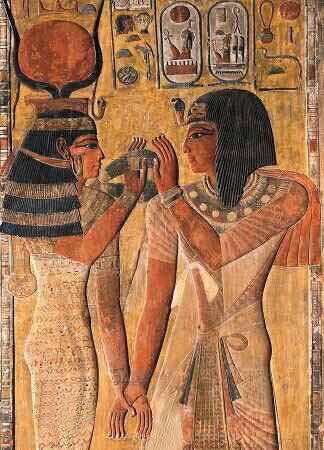In ancient Egypt marriage was considered to be for a lifetime, however, divorces were fairly common. With an average lifespan of about 30 years, boys were usually married by the ages of 15-20 y/o and girls around 12 y/o. Incest and polygamy were disapproved, except for royalty.
While the primary considerations for partners were quality of lineage, integrity, and personal habits, many couples also looked for romantic love. Many ancient Egyptian tomb drawings depict affectionate gestures between man and wife, indicating the a value of romantic love.
Men and women set out to make their spouses happy because for them marriage would go beyond the grave. More emphasis was placed on the woman's happiness, a man was expected to provide for his wife in a manner that would please her and ensure her happiness.
A wife was expected to happily provide a neat and clean house, keep herself well groomed and have well mannered children. Wives and husbands were equal, although men were the masters of their homes and the wife and children were to obey him, the wives weren’t subordinate to them.
There were no requirements for a legal ceremony for a marriage. When a couple decided to marry, or their parents arranged the marriage for them, the bride gathered her belongings and moved them into the groom's house, whereupon they were considered to be married.
When a man took a wife, it was understood that he had his own household; men didn't marry until they could afford to live on their own. They didn't marry and then continue to live with his or his wife's parents. He had to be responsible to provide for his wife and children.
Except for the very poor, a marriage in ancient Egypt usually had a contract similar to a prenuptial agreement. This document specified the bride’s price, in essence a reverse dowry; the amount the groom's family paid to the bride's family for the privilege of marrying her.
The contract specified what would be paid to the wife if the husband divorced her, the items that the bride brought into the marriage and what she would take with her in the event of a divorce. Children would go and stay with the mother, regardless of who terminated the marriage.
The marriage contracts ensured that the ex-wife was not left destitute.The agreement was compiled by the bride's father and signed in the presence of witnesses; this was usually the only documentary evidence of a legal marriage. G.Fischer, T. Allen, H.Bancroft, R. Baber, R.David.

 Read on Twitter
Read on Twitter












